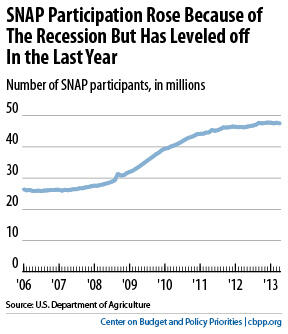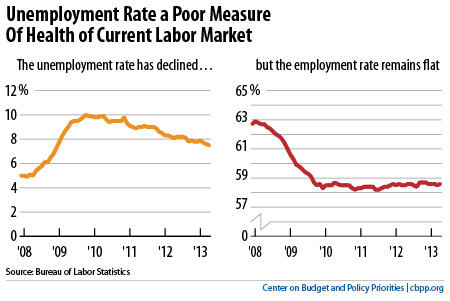BEYOND THE NUMBERS
SNAP Enrollment Is Still High Because the Job Market Is Still Bad
Enrollment in SNAP (formerly food stamps) has leveled off in the past year but remains at an all-time high (see first chart). The unemployment rate, meanwhile, has fallen from 10 percent in October 2009 to 7.6 percent last month. Some claim that since SNAP enrollment hasn’t fallen with it, most of SNAP’s enrollment growth of recent years is unrelated to the economy. The reality, however, is that SNAP enrollment and costs are still high because the job market is still weak, as our new paper shows.

The recent reductions in the unemployment rate overstate the improvements in the labor market since the economy hit bottom, as Federal Reserve Chairman Ben Bernanke recently observed. Most tellingly, the proportion of the adult population with a job (the employment rate) has barely improved since the depth of the recession. . . .
[T]he official unemployment rate does not include the large number of people who want a job — and in many cases would likely have found one in a stronger labor market — but with jobs so hard to find haven’t looked enough recently to count as officially unemployed. . . . The labor-force participation rate — the share of people aged 16 and over who are either working or officially unemployed — fell in the Great Recession and then continued to decline in the sluggish recovery. It is now at levels not seen since 1981.
As a result of the combination of a high unemployment rate and a low labor-force participation rate, the share of people aged 16 and over who have a job — what is often called the employment rate (or, more technically, the employment-population ratio) — plunged in the recession to levels not seen since the mid-1980s and has remained there.
While the percentage of workers in the labor force who are unemployed has fallen since late 2009, producing a decline in the official unemployment rate, this masks the cold reality that the percentage of the adult population with a job is still stuck at levels it fell to when the economy hit bottom (see second chart).

In a follow-up post, we’ll look at another sign of today’s weak labor market: the large number of unemployed workers who aren’t receiving unemployment insurance benefits.
